9 Times Nature Was Totes Adorbs in 2018
The Year in Cute
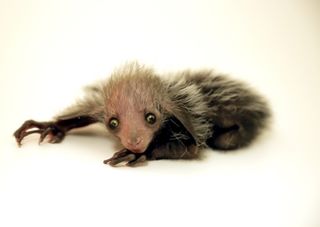
2018 was a tough news year for a lot of us, but it was also a great year for the advancement of Cuteness Studies. In May, for example, scientists discovered that puppies reach peak cuteness at 6 to 8 weeks old. This is important information that will inform many lunchtime Google image searches for decades to come.
Elsewhere around the world, a donkey fell in love with an emu, a momma duck babysat 76 fluffy babies and penguins requisitioned a research camera to take selfies. Join us now for a photographic review of 2018's most adorable scientific moments. You've earned this.
A Very Smol Octopus
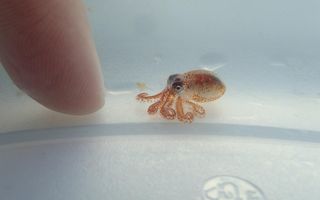
In 2018's top smol animal news, feast your peepers on this really, really, ridiculously tiny baby octopus.
This pea-sized cephalopod was spotted this August riding a piece of plastic litter in the ocean near Hawaii's Kaloko-Honokōhau National Historical Park. Park workers rescued the octo-baby from its debris boat, snapped a few pictures, then released it "safe and sound in a small protected space," the team wrote on Facebook.
Smol as he is now, this little boi now has a chance to grow. While the baby is too young to identify as a precise species, similar-looking octopi can grow to have an armspan measuring up to 7 feet (2 meters). They grow up so fast!
When Penguins Pose
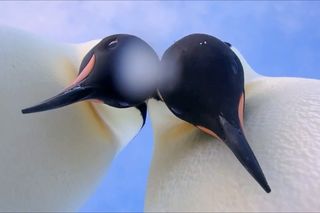
When you give a penguin a camera, it will try to take a selfie.
That was one of the (accidental) findings of a recent Antarctic research project, in which scientists left a live video camera perched near a rookery of emperor penguins. It didn't take long for the tuxedoed birds to find their watchers.
In the adorable footage that followed, the camera first focuses on the feet of two pudgy penguins as they waddle toward it — but the birds soon nudge the camera upward to focus on their faces. (And yes, even bird beaks look larger in selfies.) The penguins then make several vocalizations, as if to say, "Look what I found!" It turns out that even animals become a little vain when they know they're on camera (well, at least the best-dressed animals).
This Duck Supermom is Parenting Goals
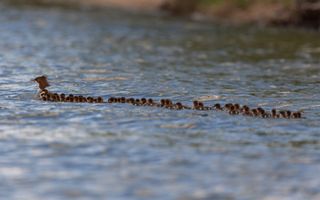
One momma bird, 76 ducklings. Experts agree: That is one duckload of beaks to feed.
For what it's worth, this Minnesota supermom (dubbed 'Momma Merganser' by nature photographer Brent Cizek) definitely didn't lay all those eggs herself; mother ducks can incubate about 20 eggs at a time, ornithologist Richard Prum told The New York Times. The other ducks following momma may be enrollees in a sort of duckling day-care system called a crèche, in which female birds entrust their newborn young into the care of an older, wiser female.
This elder babysitter is usually experienced in raising young and doesn't mind taking a few hatchlings under her wing while the little tykes' parents go off to do important adult bird things, like molt their feathers. Still, while crèches of 20 or 30 ducklings are not uncommon, one bird with 76 followers is exceptional. The mystery of Momma Merganser remains one tough nut to quack.
Aye Aye, Captain!

How bizarre can a newborn look and still, somehow, be cute? Tonks the baby aye-aye may answer that question. Born at the Denver Zoo on Aug. 8, Tonks is one of only 24 of the nocturnal lemurs in captivity in the United States. She's a squirrel-size bundle of wiry fur, beady eyes and freakishly scraggly claws, and she's somehow still absolutely adorable.
Tonks is named after the "Harry Potter" character Nymphadora Tonks, a fitting moniker given that the newborn's mother is called Bellatrix, after the "Harry Potter" villain Bellatrix Lestrange. The new aye-aye's father, another Denver Zoo resident, is named Smeagol, after the dark-loving "Lord of the Rings" character. (Perhaps you can sense a theme here.)
Aye-ayes (Daubentonia madagascariensis) are native to Madagascar. No one knows precisely how many exist in the wild, but they are considered endangered. At the risk of sounding like a nosy mother-in-law, we hope Tonks carries on the family tradition of begetting healthy, literary-themed children.
The Donkey Who Loved an Emu
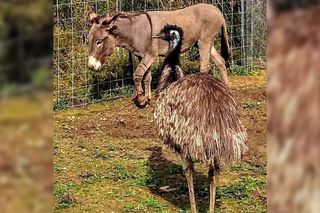
It was love at first… squawk-neigh?
Living on a farm in North Carolina, a donkey and emu named "Jack and Diane" have developed a deep bond with one another and appear to be in love. "They like to cuddle and even sleep together," Jennifer Gordon of the Carolina Waterfowl Rescue told The Charlotte Observer.
The Rescue discovered the unlikely couple when the farm's owner vanished in early November. When the cross-species lovers were put in separate pens, both showed signs of anger and anxiety (Jack, the donkey, reportedly started crying). They were promptly reunited — and hopefully they'll stay that way. Last we heard, the rescue team as currently looking for someone willing to adopt both a donkey and an emu. Could it be you??
When Elephants Eat Cereal
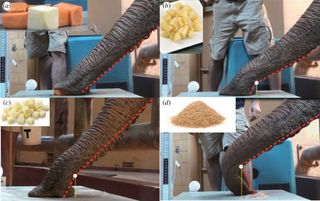
Elephants use their trunks to smell, touch and sometimes paint lovely little self-portraits. But how helpful is a trunk when it comes to eating tasty breakfast cereal?
In one of 2018's most adorable studies, scientists found out — with a lot of help from an African elephant named Kelly, who lives at Zoo Atlanta in Georgia. Researchers fed Kelly 24 plates of either chopped veggies or granular piles of bran cereal to see how the size of a meal changed the way Kelly used her trunk during feeding.
While Kelly picked up the veggies by scooping them into a tight bundle using the side of her trunk, the chalky piles of bran required a more tender approach. To eat the cereal, Kelly pressed her trunk onto the pile, pinched the tip of her trunk into a chopstick-like wedge and carried the captured pile of bran directly to her mouth. This research shows that elephant trunks are even more versatile tools than scientists previously knew — and also, elephants look really, really cute scooping up piles of treats.
The World's Punkiest Turtle
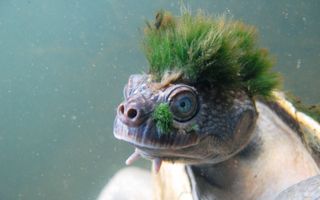
"The Mary River Turtle" would make a pretty good name for an '80s alt-rock band, but it happens to be the actual name of a tiny, green-mohawked turtle living in Australia. With whisker-like growths forking out of its chin and shocks of algae bursting off of its head like a punky green mohawk, the freshwater swimmer looks as much like an aging rocker as it does an endangered species.
Sadly, like many a rock star, this turtle is a dying breed. The rare turtle ranks 29th on a list of the world's 100 most endangered reptiles, released in April by the Zoological Society of London. One 2017 study estimated there may be as few as 136 of them left in the wild. The Zoological Society hopes to keep this number from plummeting by raising awareness of the cute, quirky creatures Earth stands to lose if habitats aren't properly protected from human encroachment.
A Brand-New Tardigrade with Spaghetti Eggs
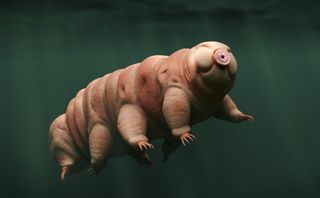
Pinkish, pudgy and oh-so-smol, tardigrades — aka "water bears" — have a newborn baby cuteness about them that's hard to ignore, even when they're making poos half the size of their own bodies.
This year, a new species of tardigrade called Macrobiotus shonaicus was discovered in a parking lot in Japan. While it has the signature round, 8-legged body of all tardigrades, this newcomer has some of the weirder eggs researchers have seen. The spherical sacs are covered in wobbly, noodle-like filaments, possibly to help the egg attach to the surface where its laid. A new tardigrade with spaghetti eggs? We'll take it!
Tardigrades, in general, are famous for their toughness: They can survive in extreme cold (down to minus 328 degrees Fahrenheit, or minus 200 Celsius), extreme heat (more than 300 degrees F, or 149 degrees C), and even the unrelenting radiation and vacuum of space, as one 2008 study reported.
I Heard You Like Moons…
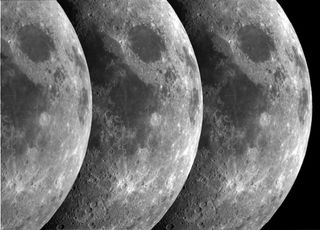
The moon is Earth's little buddy in the sky, but what if our moon had its own tiny companion to hang out with when the Earth was busy (say, during a total lunar eclipse)? We're talking about moonmoons — moons that orbit other moons.
Moonmoons (also known online as submoons, moonitos, grandmoons, moonettes and moooons) may not exist in our solar system or any other. However, according to a pair of astronomers writing in the preprint journal arXiv.org in October, the concept of a moon hosting its own mini-moon is, at least, plausible — so long as the host moon is sufficiently massive, the moonmoon is sufficiently small, and there is a wide orbital gulf between those moons and their host planet.
Whether humans will ever set foot on a moonmoon is hard to say. But if and when we do, it will truly be one (very) small step for man, and one giant leap for moonkind.
Originally published on Live Science.
Sign up for the Live Science daily newsletter now
Get the world’s most fascinating discoveries delivered straight to your inbox.

Brandon is the space/physics editor at Live Science. His writing has appeared in The Washington Post, Reader's Digest, CBS.com, the Richard Dawkins Foundation website and other outlets. He holds a bachelor's degree in creative writing from the University of Arizona, with minors in journalism and media arts. He enjoys writing most about space, geoscience and the mysteries of the universe.